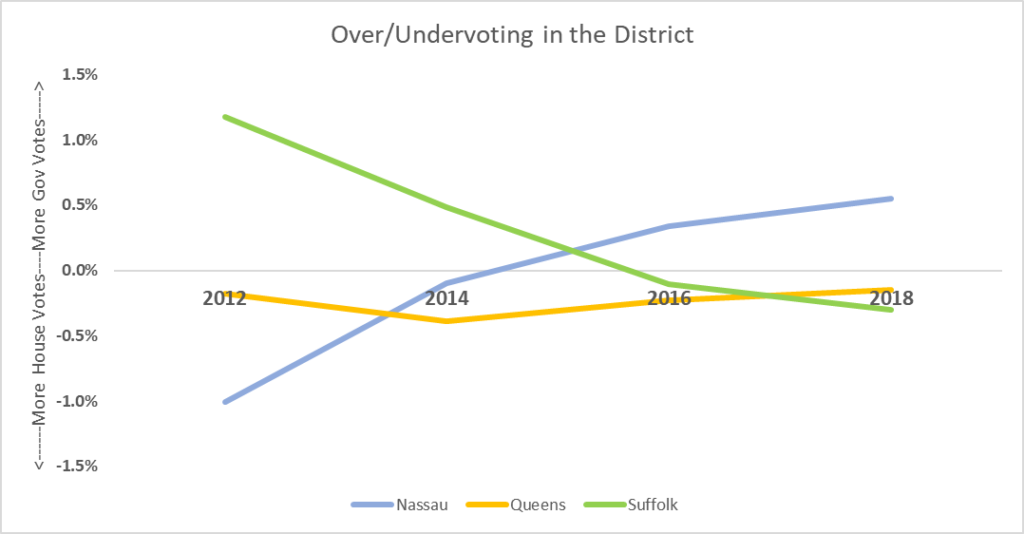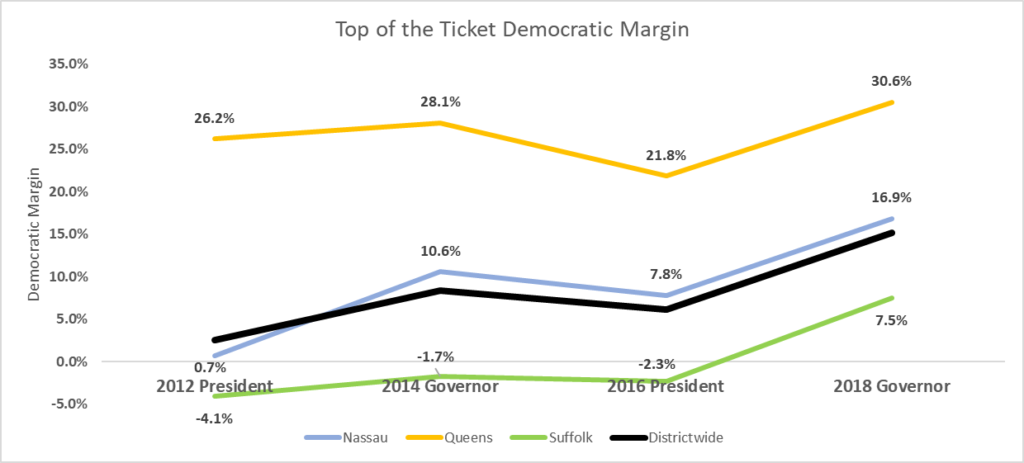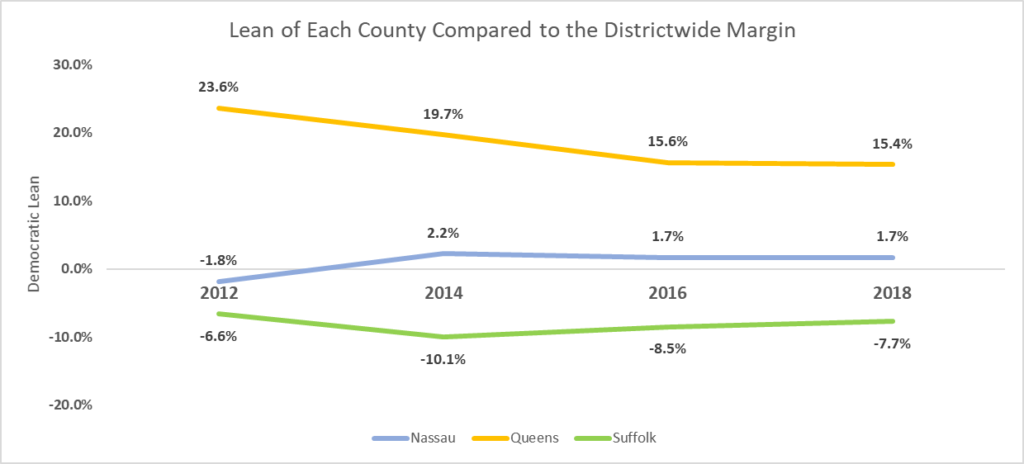New York’s Third Congressional District is a surprisingly competitive seat: Democratic Presidential candidates consistently win it by small margins and down ballot contests can get close even with token opposition. Two-term incumbent Tom Suozzi faces broadside attacks and scandals from home, granting an opening for either a Republican or progressive insurgent to hammer away.
But in a district where over half of the residents have a Bachelors’ degree, and Trump and the GOP have been stumbles with these voters, is it out of reach in 2020? Below, I hope to explore
some of the nuances and trends here to try to determine if this could be the next secret swipe for Republicans, or if its too far of an uphill climb for them.
The Fundamentals:
The district rests in the north central part of Long Island, with most of the North Shore, infamous for being the inspiration behind East and West Egg in The Great Gatsby.
More recently than that tale, it’s seen growth from suburbanite families hoping for good commutes as New York City expanded, similar to the Westchester suburbs in the north. Nassau County’s portion usually makes up half of its votes, while the rest is split about 75-25 between Suffolk and Queens, respectively shown in the graphic below.

Generally, in Presidential years, Queens, home to more minority voters, makes up a higher share of the vote while Nassau falls a bit. This past midterm was unique being such a high turnout year that Queens saw a higher share of the vote and Suffolk rebounded. There is, however an interesting trend over the last four cycles. This chart shows the difference in under and over voting, (only marking a ballot for one of the races). A county above the line with a positive value means that it made up a larger share in the Governor’s race while below means that there were more votes for the House contest.

In 2012, Suffolk had an outsized impact in the governor’s race but has switched spots with Nassau, which now under votes in the House race. It’s interesting that Rep. Tom Suozzi was elected in 2016, and the slide seems to have slowed, but still continues.
Governor Andrew Cuomo in 2010 and 2014 typically overperformed Presidential candidates downstate, from Staten Island to Long Island. Obama won NY-3 by only 2.6 points (50.8-48.2%) while Clinton improved marginally, winning it by 6.1 points (51.6-45.5%). Small a shift it may be, it further represents a shift in the lean of the district: Obama won New York by 28.2% but Clinton only won by 22.5% (making the 2012 state lean R+25.6 and the 2016 lean R+16.4) Cuomo would go on to win NY-3 by 8.4% in 2014 and a whopping 15.2% in 2018 (making the gubernatorial lean R+5.6 in 2014 and R+8.2 in 2018).

Cuomo’s over performance of Obama in the 2014 gubernatorial election came because of a large boost in Nassau that continued for Clinton, though she lost ground in Queens as African-American turnout lagged. In 2018, Cuomo improved everywhere with near-uniform 9-point boost, and he notably carried Suffolk by a considerable amount. These trends are further illustrated when you look at the lean at the top versus the running county margins.

Democrats have been steadily losing their edge in the Queens portion, but the last two cycles in the Suffolk portion has seen them make gains, mitigating the difference. Any Republican will have to maintain a decent margin in Queens while reversing the slide in Suffolk or at least keeping it from worsening. This is tough, as the latest estimates show that 53% of the district holds a Bachelors’ degree and about 25% hold a post graduate degree. These are the voters Trump has struggled with, and that struggle spread to Republicans down ballot last year in the House. The biggest challenge to Republicans taking back the district comes from the chart below. Trump likely won’t improve here or get 50% unless there is significant over performance, so a Republican Congressional candidate will have to rely on split ticket voting. But 2018 saw virtually no variation in each county as Suozzi over performed the top of the ticket by the standard 2.8% for an incumbent.

The lack of noticeable deviation between the counties in 2018 is not the only weird trend. Since Steve Israel retired and Suozzi was elected in 2016, the Suffolk over performance vanished with better performance in Queens. Any GOP candidate will need split ticket voters, particularly those in Suffolk and Nassau that had been willing to vote Republican in the late Obama era. Money compounds the Republicans’ problems. Suozzi has outspent his challenger by about $1M over the last 2 cycles and his opponent last year raised and spent less than $500k.
The Democratic Split:
The biggest intrigue, with a Republican challenge uncertain, will be the Democratic primary. Tom Suozzi was the mayor of Glen Cove before becoming the Nassau County Executive in 2001 for 8 years. After losing re-election narrowly in 2009, he tried to win a new term in 2013 only to get shellacked by 18 points. His big political comeback came in 2016, when he won his current Congressional seat by a margin of five percent. In Congress, he has been Vice-Chair for the Problem Solvers Caucus, a bipartisan handful typically far more moderate than the party caucus. It is focused more on forcing rules changes to empower minority parties, and has been more pro-business than typical Democratic-dominated caucuses.
Suozzi has broken ranks with the liberal wing of the party, supporting ICE during a July appearance on Fox and made an under the radar appearance at an AEI conference with mostly Republicans and a few moderate Democrats from the Problem Solvers Caucus. Suozzi was also put on the Ways and Means Committee as a NYC Democrat (though his district as we’ve seen is only a sliver of Queens) over the protestations of progressives prodding for freshman star Alexandria Ocasio-Cortez. Suozzi has noticed this, and last month came out in favor of the Green New Deal proposal, but at this point it might be too late to avoid a challenge. The Justice Democrats and liberal provocateur Sean McElwee have put Suozzi on “primary watch.” When asked for a comment about the contest for this article, McElwee confirmed that when it comes to NY-3, it “remains one of the top blue to blue prospects.”
The Congressman’s left-wing opponents are eyeing DNC member Robert Zimmerman, who has called Suozzi a “Trump sympathizer”. When pressed for further comment, Zimmerman stressed that he has been on a general listening tour, communicating with both progressive and mainstream Democratic activists and leaders, and that he was “surprised by the level of excitement and interest” and stressed how he felt that it spoke to “a demand that the citizenry overall, and Democrats have, not to placate the right wing.”
Beyond his votes and general actions as a Congressman, Suozzi has been dogged by his refusal to go against a utility company with a monopoly that has raised rates and could bankrupt a local school district if said entity is successful in suing to reduce its property taxes. Beyond opposing the Long Island Power Authority, or LIPA on this, his cousin Ralph Suozzi serves as Chairman on its Board of Trustees, and the Congressman has taken donations from additional utility execs. Expect to see his favor of utilities become an issue if Zimmerman or another progressive commits to a primary fight.
I wrote a previous piece here using data from the 2008 and 2012 cycles where I explored the phenomenon that moderate House candidates typically overperform more than ideologically extreme ones, and the ideological placement against your opponent has a large impact. As a moderate, however, Suozzi has not overperformed much, and 2018 showed little difference in ticket splitting. If Trump bleeds any more with well educated voters here, the Democrat, be it Suozzi or a successful primary foe, hasn’t much to worry about. If Republicans can’t drag Suffolk back and tamper down Nassau margins, this will be another large Democratic margin in 2020. So far, no Republican has expressed interest and as Crystal Ball rates the seat as Safe Democratic, recruitment efforts will probably remain poor. If Republicans, find their station improving in 2020 among college educated whites, things could take a turn.
Either way, it’s worth watching this seat both in the primary (especially as the moderate-usually-over performs argument didn’t hold here) and the general. Suozzi could find himself in the battle of his short Congressional life.